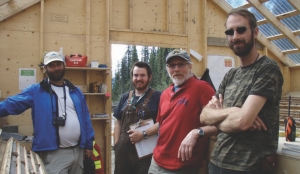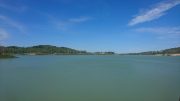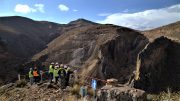SITE VISIT
KENO, YUKON — The Carlin trend is world renowned, and deservedly so, as the 200-sq.-km stretch of ground in northern Nevada boasts more than 100 million ounces of past gold production and current gold resources. It is also famous for being unique — geologists have spent the last 40 years searching for another Carlin-type district, but to no avail.
That is, until now.
Atac Resources (ATC-V) used regional prospecting to home in on a long, narrow belt of rocks in the eastern Yukon that may just be the next Carlin. The company’s first hole into its first Carlin-esque target returned a whopper intercept: 4.65 grams gold per tonne over 65.2 metres. And importantly the mineralization in that hole came in carbonaceous rocks showing signs of a debris- flow genesis that were also impregnated with orpiment and realgar, which are arsenic minerals.
Why are those characteristics important? Because they are precisely the characteristics found in the gold deposits of the Carlin trend.
The market immediately realized the significance of the first hole in the Osiris target and within three days Atac’s share price rocketed up from $2.50 to $7.25. It has since settled to the $6 to $6.50 range, but the excitement is still very much real.
Atac has drilled another seven holes into the ground around Osiris, with promising results. And while Osiris is the new darling at the Rau gold project, Atac is also busy calculating a resource estimate for the Tiger zone, the hydrothermally oxidized gold zone discovered three years ago that has produced such intercepts as 8.7 grams gold over 59 metres.
All told, the 200-km long Rau project has rapidly become one of the most intriguing operations in the world. With heavy snow on the ground in the Yukon, Atac has retreated to Vancouver to analyze data and plan for 2011, knowing that it is likely on to something big.
The project
The Rau project is not part of the Tintina gold belt, where much of the current Yukon gold exploration craze is focused. Instead, Rau is some 50 km northeast of Keno City, and about 100 km east of the Tintina.
The difference in location is important. Atac did not stake its Rau property based on other discoveries but based on anomalous arsenic stream geochemistry. The company had a theory that the Yukon had carbonate-hosted gold potential, and one of the key indicators for those kinds of deposits is arsenic.
After the arsenic anomaly drew them to the area, Atac’s geologists found precisely the lithology they sought: mapping indicated the Rau area comprised a Paleozoic carbonate slice that had been carved off the Selwyn basin tectonic province, to the east, and left sandwiched between two major structures. The Dawson thrust bounds the carbonate slice to the south and the Kathleen Lakes fault cuts it off to the north. The company staked the narrow band of favourable rocks, creating a property that stretches for 200 km east-to-west but averages only 15 km in width, and named it the Rackla gold belt.
After a season of sampling and prospecting the new project, Atac discovered the Tiger zone. Tiger is in the middle of the Rau property, in an area where the rocks are older and the carbonates show fossilization, indicating a shallow water origin. Three rounds of drilling have now shown Tiger to host interbedded limestones, which carry gold, and basalt flows, which acted to contain the mineralizing fluids.
Those fluids came up deep north-south faults that cut through the zone and deposited gold. And lots of it — Tiger has returned many intercepts grading better than 10 grams gold, over significant widths. The fluids that deposited gold also oxidized the rock, which means Tiger contains leachable oxide gold to almost 300 metres depth. Usually oxidation occurs through groundwater seeping downwards, which limits oxide deposits to less than 100 metres in depth.
The result is a high-grade, oxidized-gold zone that starts essentially at surface. For example, some of the better drill results from Tiger include 38.8 metres of 17.1 grams gold from 33 metres depth, 32.6 metres averaging 8.91 grams gold from 30 metres depth, and 75.8 metres carrying 5.57 grams gold from 12 metres. The zone has now seen 132 drill holes and an initial resource estimate is pending. And Tiger is part of a 15-km long ridge system where Atac has identified more than a dozen other targets that show signs of hosting similar, hydrothermally oxidized gold mineralization.
“With oxide gold at these grades, it’s a licence to print money,” says Rob Carne, president of Atac. “It’s the type of gold deposit that may be small but is technically fantastic, and there are likely several more along the trend.”
Tiger was enough to make Rau an interesting project. But the Atac team never stopped doing reconnaissance work across its land package searching for signs of carbonate gold and, in 2010, it discovered two other interesting areas: Osiris and Ocelot.
Osiris comprises a south dipping, carbonate dominated sedimentary sequence. Within that sequence the target is a limestone debris-flow horizon 150 metres to 200 metres thick. The horizon’s karsted nature suggests it formed at the edge of a reef, where chunks of limestone continually broke off and tumbled downward, leaving behind openings.
The Osiris horizon has been tracked on surface for 2.5 km. At its north end it runs up the east side of a ridge, then turns north down the mountain, exposing 300 metres of vertical continuity.
And just 100 metres to the west Atac found a second target horizon, dubbed Isis. Isis is identical to Osiris: a limestone debris-flow unit 150 to 200 metres thick, bounded by mudstones and gritty limestones that were less permeable to fluid flow and appear to be unmineralized. Isis is above Osiris, stratigraphically.
Atac jumped onto exploration at Osiris and Isis, completing a soil sampling and mapping program in just eight days in preparation for drilling. The effort was rewarded with a huge hit in the very first hole.
Hole 1 returned 4.65 grams gold over 65.2 metres, starting 56 metres downhole, as well as an 8.8-metre intercept of 1.81 grams gold from 7.6 metres depth. The main intercept included several intervals of black, sooty, carbonaceous rock grading better than 40 grams gold.
The news hit the markets hard. Carlin-style alteration assemblages, complete with orpiment and realgar, in the Yukon? If the news had not come from Atac, which is backed by the long-time Yukon prospecting and consulting company Archer Cathro, investors may not have believed it. But Archer Cathro’s credibility helped people believe, and Atac’s share price tripled in as many days.
Excited investors then had to wait two months for the rest of the Osiris area results, which were released in late November. Hole 2 hit 35.1 metres of 2.31 grams gold from 72 metres depth and bottomed in mineralization. Hole 3 cut 22.3 metres averaging 2.21 grams gold from 105 metres depth. Hole 4 returned two mineralized intercepts: 16.8 metres of 2.03 grams gold from surface and 7.2 metres of 8.37 grams gold from 229 metres downhole. And hole 6 produced one short hit: 4.9 metres at 1.76 grams gold from 4 metres downhole.
Even though the second set of results fell short of the expectations set by hole 1, the cores all showed Carlin-style lithology: stacked gold-bearing intervals within favourable limestone debris flow units linked by feeder structures. And the fact that Atac discovered three other Carlin-style targets within 8 sq. km around Osiris only increased the potential at what is now called the Nadaleen trend.
The Nadaleen trend covers Osiris, Isis, and the three new targets, called Conrad, Eaton and Isis East. Like Osiris and Isis, Conrad and Eaton both occur along the Nadaleen fault, which provided the name for the trend because Atac believes the east-west structure may have been the feeder structure for the area. Spring water precipitate samples taken 4 km west of the Conrad-Eaton are
a graded 15.5% arsenic and a mineralized mafic dyke occurs along the fault, a common feature of feeder structures in the Carlin trend.
Conrad is 2 km east of Isis and was identified through a subdued gold geochemical signature. Four rock samples collected along a 200-metre portion of the anomaly graded 21.4 grams gold, 21.9 grams gold, 40.3 grams gold, and 66.6 grams gold, while a continuous channel sample taken across the width of the partially exposed portion of the zone assayed 14.89 grams gold over 2.3 metres.
Atac had time to punch one hole into Conrad before the end of the exploration season. Like Osiris, it returned a fantastic first hit: 21.1 metres grading 8.03 grams gold, including 12 metres of 13.6 grams gold. And in terms of elevation the Conrad discovery sits 500 metres below Osiris, confirming a significant vertical extent of multiple, stacked mineralized zones.
Eaton is just 400 metres east of Conrad. Characterized by a large area of clay alteration, limited grab samples returned gold grading up to 1.02 grams. Atac also punched one hole into Eaton and hit 39.8 metres of 1.61 grams gold, including 9.6 metres of 3.36 grams gold. Interestingly, the intercept at Conrad occurs within silicified or jasperoid-altered calcareous sandstone, a different host rock.
And Isis East is, as the name implies, related to the Isis target. Atac’s only hole into Isis returned two intercepts: 17 metres at 0.92 gram gold from 32 metres depth and 3.1 metres of 1.49 grams gold from 78 metres. The mineralized zones were Carlin style, with decalcified limestone carrying gold, orpiment and realgar, and fine-grained pyrite. Isis East is simply an eastward extension of the Isis zone.
Across the Nadaleen trend the highest gold grades to date are associated with intense decalcification or decarbonatization and clay alteration of limestone, accompanied by enhanced thallium content. These are key Carlin characteristics.
“Osiris is true Carlin,” says Carne. “There are karsts the size of Volkswagen bugs over there.”
The Noraleen trend discoveries are all very new — remember that Atac discovered Osiris just six months ago. As such there remains significant potential to discover more areas of interest within Noraleen. Already a regional stream sediment sampling program has identified three streams carrying anomalous arsenic values; one stream is 4 km east of Osiris while the other two are 10 km and 20 km west.
Atac is planning a 40,000-metre drill program at Rau in 2011. The majority of the drilling — 30,000 metres — will test the Nadaleen trend targets. The other 10,000 metres of drilling will be directed at five of the best oxide gold targets within 5 km of the Tiger zone. One of those targets, known as Cheetah, saw one hole in 2010 that returned 16.9 metres of 1.29 grams gold.
Finally, Atac will also probe the Ocelot target. Ocelot is a silver- lead-zinc target located 15 km west of Tiger. Surface samples taken from the discovery outcrop returned grades as high as 2.8 kg silver per tonne, 80.6% lead, 40.6% zinc, and 3.16 grams indium per tonne. Four reconnaissance holes then tested the Ocelot area in 2010, with hole 1 returning the best result: 360 grams silver, 9.83% lead, 25.06% zinc, and 48.2 grams indium over 4.2 metres. Geophysical anomalies extend 1.3 km west and 500 metres east of the Ocelot showing.
Who and where
As with any exploration project, the people behind the company and the location of the project are important.
As mentioned, Atac was borne out of Archer Cathro, a respected geological consulting group focused on the Yukon. Rob Carne, Atac’s president, was a principal at Archer Cathro until coming over to Atac. Carne has been exploring in the Yukon for 28 years and is best known for having coined the term “SEDEX” to describe sedimentary- exhalative zinc-lead deposits.
Carne’s connection to Archer Cathro means Atac has continual access to the consulting firm’s expertise and databases, which it has been developing for more than 30 years. Archer Cathro’s president, Bill Wengzynowski, is a regular consultant at Rau and other Archer Cathro geologists have worked with Atac since the beginning.
As for location, Rau is both isolated and accessible. At its closest point, the 200-km-long project is 50 km from a road and a power line, along a broad valley. Atac is working to permit a winter road along the valley; the road would lead almost directly to the Tiger zone, which is in the centre of Rau. However, Osiris is 100 km east of Tiger, which means the Nadaleen-trend targets are 150 km from any infrastructure.
More generally, the Yukon is becoming famous for being a jurisdiction that encourages mineral exploration and supports development. In the Fraser Institute’s latest ranking of the world’s best jurisdictions for mineral exploration, the Yukon placed fourth out of 51, up from 21st spot five years ago. The territory boasts settled land claims with 11 of 14 First Nations and a government that has embraced responsible exploration as a key part of the Yukon’s future.
The Yukon is experiencing a modern gold rush and, while much of the attention has gone to the White Gold district, Atac is a major part of it.
“Everything that’s happened in the Yukon recently have been truly new discoveries,” says Carne. “The problem is there was very little regional exploration here in the last 20 years — in the 1970s it was common for big companies like Teck to do big regional programs, but that’s not the case anymore.
“In the last ten years it’s only (prospector) Shawn Ryan and us, at Archer Cathro, who have done any real, generative prospecting,” he continues. “And now there have been three significant discoveries, two by Shawn and one by us. We hope that can stimulate more of that regional, generative work, because there is a lot more to be found here.”
Atac has a 52-week trading range of $1.19-$9 and 91 million shares outstanding, with no warrants. The company had $27 million in the bank at the end of September.






Be the first to comment on "Atac revels in rewards"